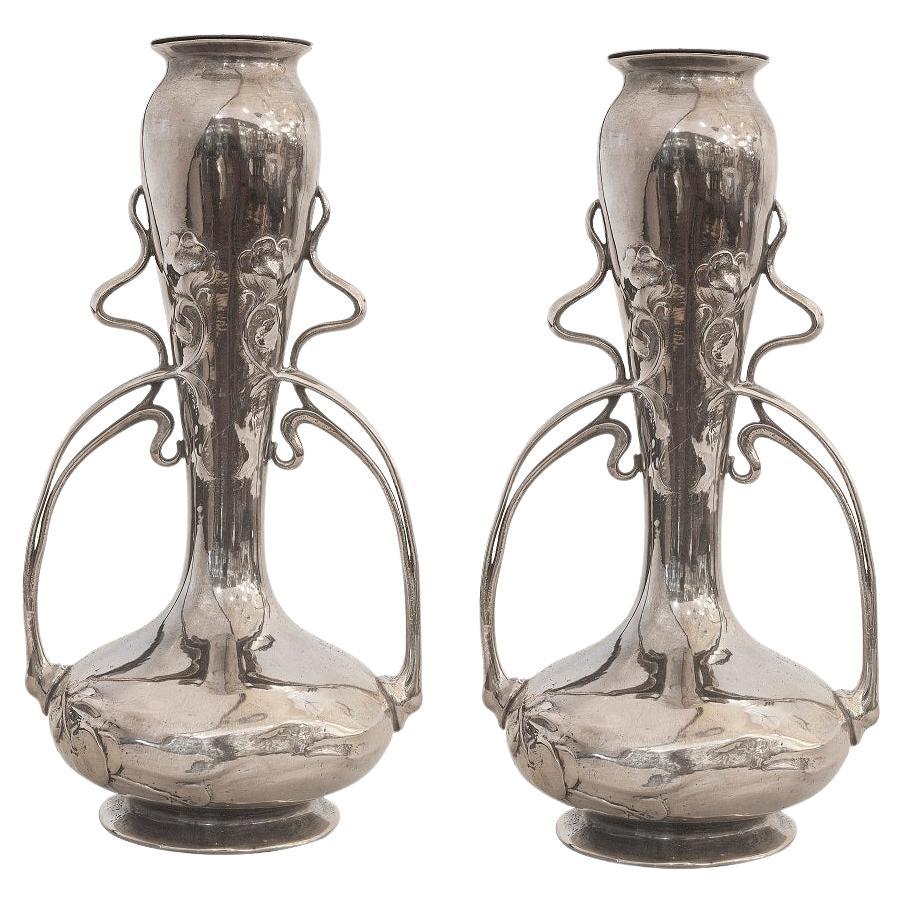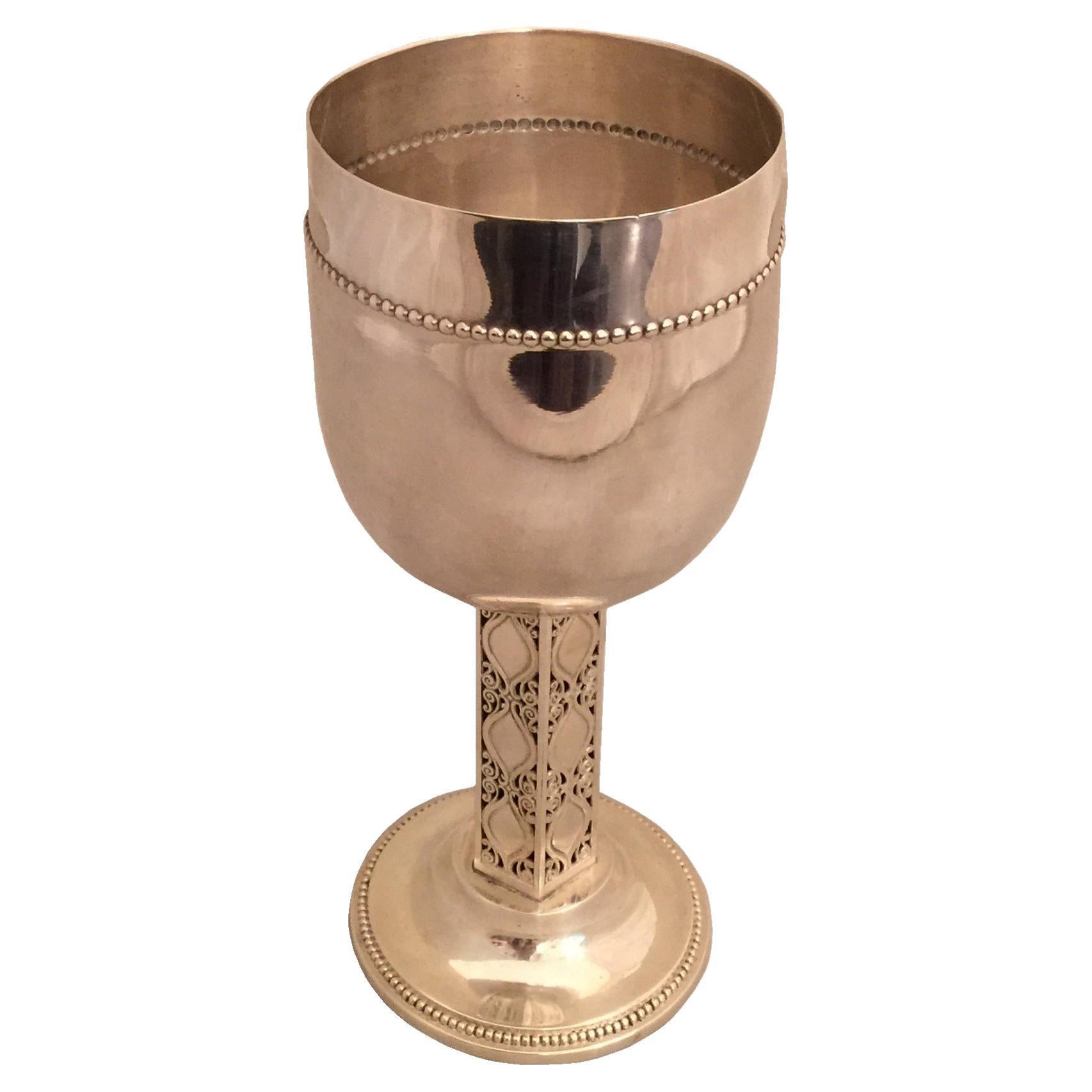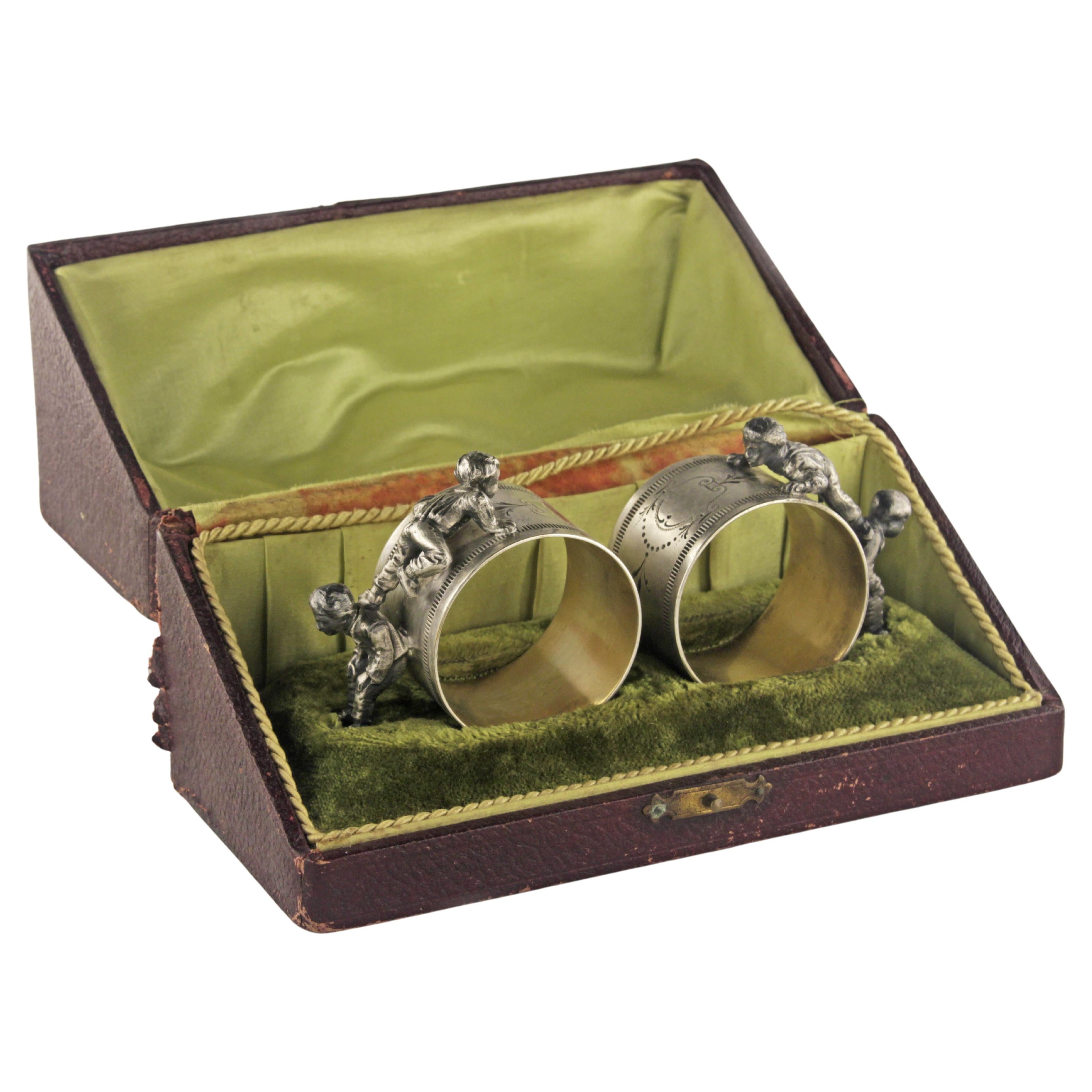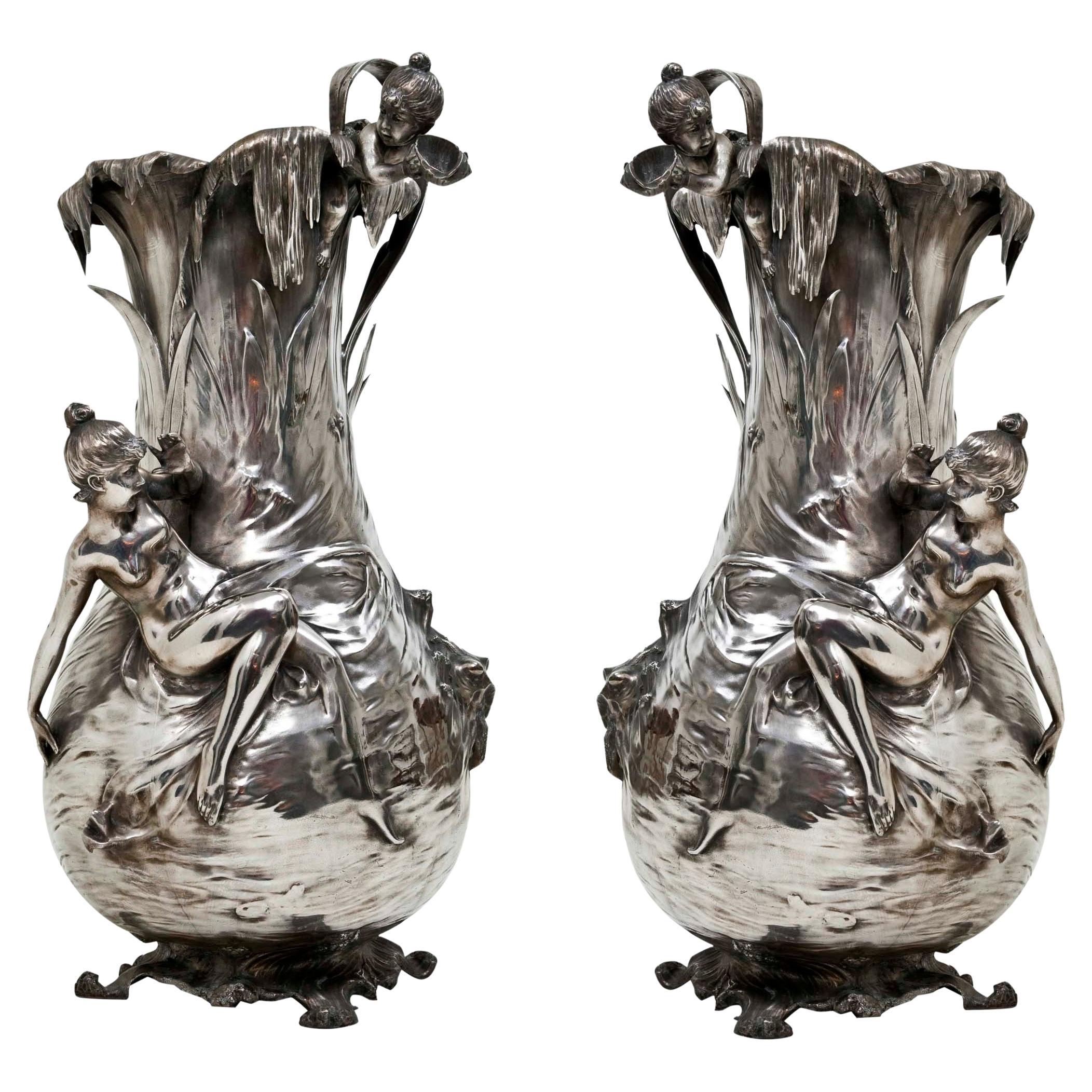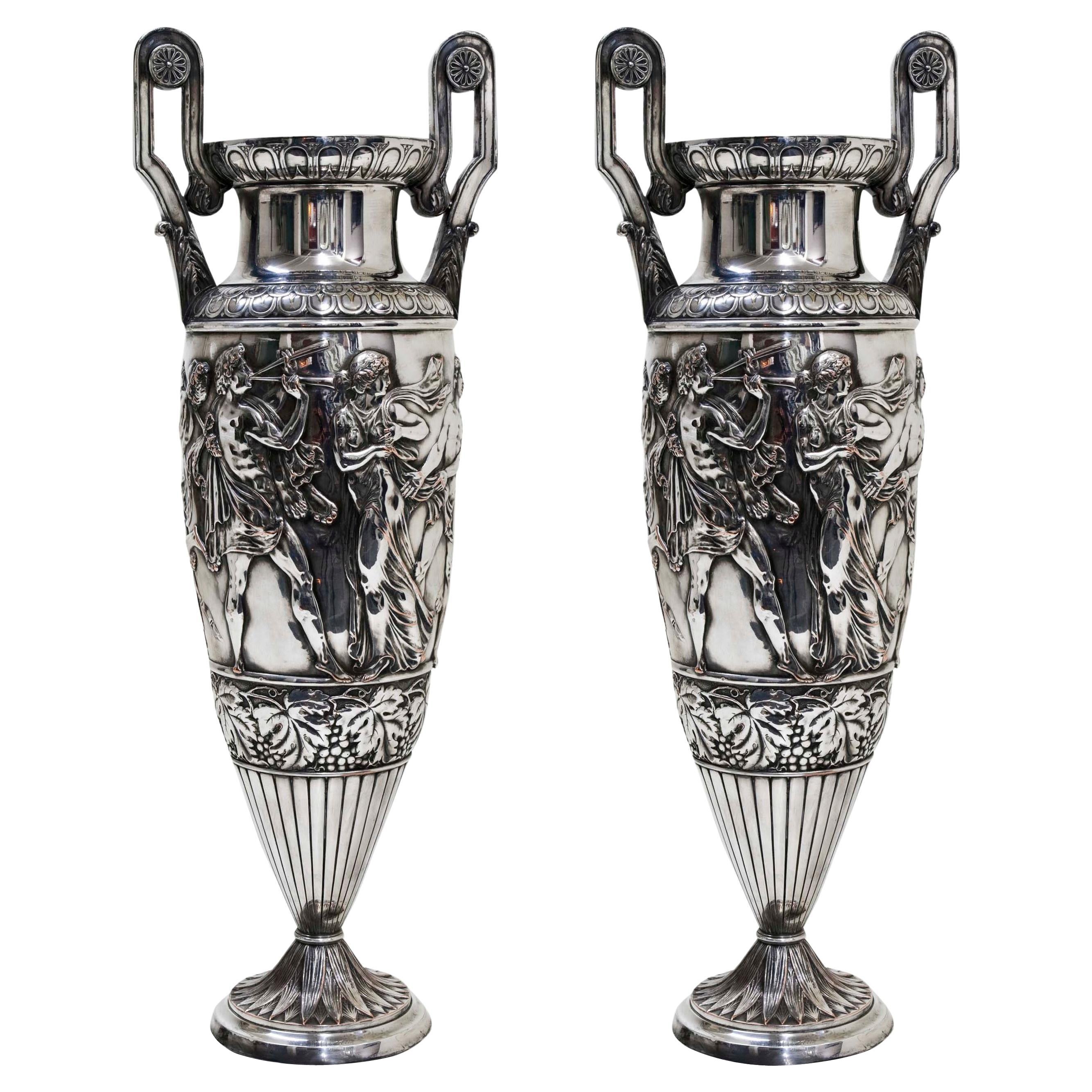Items Similar to WMF, A Pair of German Jugendstil Copper and Wood Challises, circa 1910
Want more images or videos?
Request additional images or videos from the seller
1 of 5
WMF, A Pair of German Jugendstil Copper and Wood Challises, circa 1910
About the Item
This pair of challises is a rare example of the famous WMF early Jugendstil objects, famous among collectors for their unique style and an unusual combination of materials - in this case, copper and wood. The bottom is marked with a beehive stamp with a running ostrich in the middle. As this particular early mark was introduced in 1909 and Y mark was in use only up to 1914, we estimate the approximate year of the manufacturing, as 1910.
WMF
Originally Würtemburgische Machin Fabrik AG, WMF was originally founded in 1853 in Geislingen an der Steige, Germany. In 1880, there was an amalgamation of Straub & Sohn and A Ritter & Co. and the factory became famous for domestic and art metal ware with an appropriate change of name to Würtemburgische Metallwaren Fabrik AG. A variety of marks have been used during their 150 years of production. The well-known 'ostrich' mark originates from the German word for ostrich, 'Der Strauss' after Daniel Straub, one of the founders. The 'G' in the mark stands for the town of Geislingen, on the River Fils and near Ulm in Baden-Württemburg.
- Creator:WMF Württembergische Metallwarenfabrik (Manufacturer)
- Dimensions:Height: 10.88 in (27.64 cm)Diameter: 4.88 in (12.4 cm)
- Sold As:Set of 2
- Style:Jugendstil (Of the Period)
- Materials and Techniques:
- Place of Origin:
- Period:1910-1919
- Date of Manufacture:circa 1910
- Condition:Wear consistent with age and use. We make a best effort to provide a fair and descriptive condition report. Please examine the photos attentively, as they are an integral part of item descriptions.
- Seller Location:New York, NY
- Reference Number:1stDibs: LU281938591933
About the Seller
5.0
Vetted Seller
These experienced sellers undergo a comprehensive evaluation by our team of in-house experts.
Established in 1993
1stDibs seller since 2017
68 sales on 1stDibs
Typical response time: 2 hours
- ShippingRetrieving quote...Ships From: New York, NY
- Return PolicyA return for this item may be initiated within 10 days of delivery.
More From This SellerView All
- WMF, German Jugenstil, a Pair of Copper & Brass Candlesticks, Ca. 1910By WMF IkoraLocated in New York, NYDETAILS Marked on bottom. WMF GmbH In 1853, mill owner Daniel Straub, together with the Schweizer brothers, Louis and Friedrich, established the Straub & Schweizer metal works in Geislingen an der Steige, Germany. Only a few years later in 1862, their silver-plated tableware and serving dishes were awarded a medal of distinction at the world exhibition in London. The company, originally called Metallwarenfabrik Straub & Schweizer, merged in 1880 with Ritter & Co - a producer of high end luxury items who were ahead of their time in silver plating technique. Instead of using the method of heat and mechanical pressure to plate their wares, Ritter dipped the item into a bath of silver which together with an electric current produced pieces that were finely and evenly covered in a layer of silver. This method of plating was called ‘Galvanisation’ and allowed more intricate and complex pieces to be plated. After several years both companies still faced financial problems and in 1880 they joined with the Wurttemberg Union Bank and the company was renamed “WMF” (Württembergische Metallwarenfabrik). From its founding as one company, WMF's growth was tremendous - acquiring more factories along the way, notably including "Orivit AG" and "Orion KM". By the end of the 1900's, they were the world's largest producer and exporter of household metalware. WMF started making glass in 1883 when a glass house was built at Geisslingen near Stuttgart to produce their own glass inserts. The original 1883 glass house was destroyed during the First World War and a new, more modern facility opened in 1922. The young glass designer Karl Wiedmann perfected the technique of iridized surfaces and the resulting "MYRA"- Kristall entered production in 1926. The same year also saw the beginning of the first "IKORA" glass - reputedly discovered by accident whilst correcting a Myra glass...Category
Vintage 1910s German Jugendstil Candlesticks
MaterialsBrass, Copper
- German Tromp L'oeil Silver Brotherhood Wine Vessel, 19th CenturyLocated in New York, NYA rare 19th century German "Bruderschaft" (Brotherhood) wine vessel in form of a wine barrel, consisting of two separate cups, connected by a chain with a lock. With gilded interior,...Category
Antique 1870s German Baroque More Dining and Entertaining
MaterialsSilver
- Austrian Jugendstil Vienna Bronze Sculptural Paperweight by Carl Fiala, ca. 1910Located in New York, NYABOUT This elegant Austrian Jugenstil sculptural desk paperweight depicts some fantastic half-human creature from the underwater world, riding a snail. Signed C. Fiala, dark-green co...Category
Vintage 1910s Austrian Jugendstil Paperweights
MaterialsBronze
- Paul Leibküchler, Sisyphus, German Jugenstil Bronze Sculpture, circa 1900By Paul LeibküchlerLocated in New York, NYThis extremely impressive depiction of Sisyphus, the figure from Greek mythology in darkly patinated bronze as an athletic male figure with energetic facial expression, wearing only a loincloth, stiffening a boulder over his right shoulder, on round, geometrically decorated plinth. In Greek mythology, Sisyphus was the king of Ephyra (now known as Corinth). He was punished for his self-aggrandizing craftiness and deceitfulness by being forced to roll an immense boulder up a hill only for it to roll down when they near the top, repeating this action for eternity. Through the classical influence on modern culture, tasks that are both laborious and futile are, therefore, described as Sisyphean labour. Signed by the artist on the plinth: “Leibküchler fec.” (for Paul Leibkuchler...Category
Antique Early 1900s German Jugendstil Figurative Sculptures
MaterialsBronze
- Carl Kauba, Bookworm & Art Connoisseur, a Pair of Bronze Sculptures, circa 1910By Carl KaubaLocated in New York, NYBoth sculptures are signed ‘C. Kauba’ on the plinth. Dimensions: 9.75” high x 3.75” deep x 3.5” wide Dark brown patina. Original marble pedestals. Carl Kauba (Austrian, 1886 – ...Category
Vintage 1910s Austrian Romantic Figurative Sculptures
MaterialsMarble, Bronze
- Franz Xavier Bergmann Pair of French Bulldogs Miniature Vienna Bronze circa 1900By Franz BergmannLocated in New York, NYNoted for his detailed and colorful work, Bergman was signing his creations with either a "B" in an urn-shaped cartouche, or "Nam Greb" - for "Bergman" in reverse (these marks used t...Category
Antique Early 1900s Austrian Jugendstil Animal Sculptures
MaterialsBronze
You May Also Like
- Jugendstil Copper and Brass Teapot by Atelier Mayer for WMF, Germany, 1905-1910By WMF Württembergische MetallwarenfabrikLocated in Chicago, ILJugendstil copper and brass teapot set by Atelier Mayer for WMF, Germany, 1905-1910 Dims are of teapot alone.Category
Early 20th Century German Jugendstil Tea Sets
MaterialsMetal
- Vases, Jugendstil, Art Nouveau, Liberty, German, 1910, WMFBy WMF Württembergische MetallwarenfabrikLocated in Ciudad Autónoma Buenos Aires, CCenterplace, WMF, German We have specialized in the sale of Art Deco and Art Nouveau and Vintage styles since 1982. If you have any questions we are at your disposal. Pushing the...Category
Vintage 1910s German Art Nouveau Vases
MaterialsMetal
- Cup, Jugendstil, Art Nouveau, Liberty, German, 1910, Sign: WMFBy WMF Württembergische MetallwarenfabrikLocated in Ciudad Autónoma Buenos Aires, CCup, WMF, German sign: WMF G: Introduces on the 1 st June 1910, in the interests of improved legibility, especially of the very small marks. The company´s choice of an ostrich as a t...Category
Vintage 1910s German Art Nouveau Wine Coolers
MaterialsMetal
- Pair of Jugendstil Silver Napkin Rings and Decorative Box by German Makers WMFBy WMF Württembergische MetallwarenfabrikLocated in North Miami, FLPair of early 20th century Jugendstil/Art Nouveau silver napkin rings and decorative box by german manufacturer Württembergische Metallwarenfabrik (WMF) By: Württembergische Metallwarenfabrik (WMF) Material: silver, wood, thread, velvet, cord, fabric, metal, silver plate Technique: cast, gilt, patinated, polished, metalwork, silvered, plated Dimensions: 5 in x 7.5 in x 3.5 in Date: Late 19th Century, circa 1885 Style: Jugendstil, Art Nouveau, Belle Époque, Arts and Crafts Place of origin: Germany This is a set of two napkin rings made of gilt, patinated and polished silver, with carved decoration. Both rings feature figures of young boys climbing up one side of the napkin holder. The edges of each piece show the markings 'WMF' (manufacturer's hallmark), 'I/O' (purity mark; in this case it means regular silver coating is used) and 'ig' (process of the silver; in this case it means it's gilt). They come with a decorative box to rest the rings, made of wood lined with fabric inside and a velvet surface surrounded by an ornamental rope. WMF is the abbreviation for Württembergische Metallwarenfabrik, which in English means Wurtemberg Metalware Factory. WMF was created in 1880 after the successful merger of two Wurtemberg foundries, the Geislingen factory and the Esslingen factory. The first foundry was commercially more successful, while the second one was using a more advanced technology of galvanic silver deposition. In 1881 the Esslingen factory was dismantled and its equipment was incorporated into the Geislingen foundry. During the next thirty years WMF experienced a period of rapid expansion, which lasted until the beginning of the World War in 1914. The WMF silver-plated production made this period of time (1880-1914) is extremely popular among western antiques...Category
Antique 1880s German Jugendstil Tableware
MaterialsSilver, Metal, Silver Plate
- Pair of Big Vases Wmf, German, 1910 in Silver Plated, Jugendstil, Art NouveauBy WMF Württembergische MetallwarenfabrikLocated in Ciudad Autónoma Buenos Aires, C2 Vases WMF Signs: Page: 371 in the Book – Art Nouveau Domestic Metalwork from WMF Wurttembergische Metallwarenfabrik: The English Catalogue 1906 Hardcover. WMF G: Introduces on ...Category
Vintage 1910s German Art Nouveau Vases
MaterialsMetal
- Pair of Big Vases Wmf, German, 1910 in Silver Plated, Jugendstil, Art NouveauBy WMF Württembergische MetallwarenfabrikLocated in Ciudad Autónoma Buenos Aires, C2 Vases WMF Signs: WMF G: Introduces on the 1 st June 1910, in the interests of improved legibility, especially of the very small marks. The company´s choice of an ostrich as a tr...Category
Vintage 1910s German Art Nouveau Vases
MaterialsMetal
Recently Viewed
View AllMore Ways To Browse
Herend Chanticleer
Hermes Les Toucans
Ivory Napkin Rings
Mauviel Copper
Plateria Lopez
Kartell Flutes
Kartell Jellies Espresso Cups
Crumb Sweeper
Digsmed Spice Rack
Johannes Siggard
Vera Neumann Linens
Vintage Brass Skewers
Vintage Crumb Sweeper
Vintage Kitchen Rolling Pin
Vintage Spice Rack Spice Jars And Racks
Wall Mounted Teak Spice Rack
William Abdy
Antique Baguette Cutter

